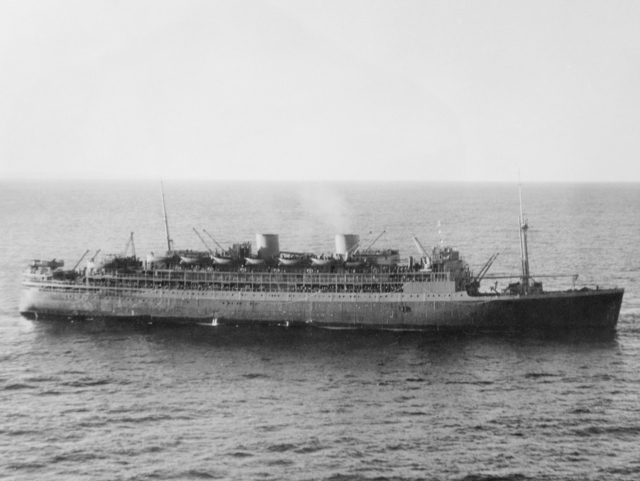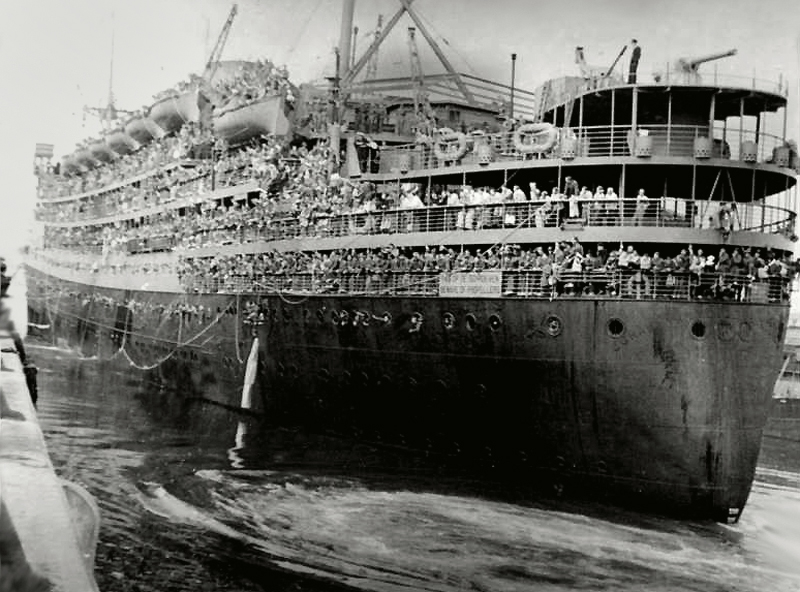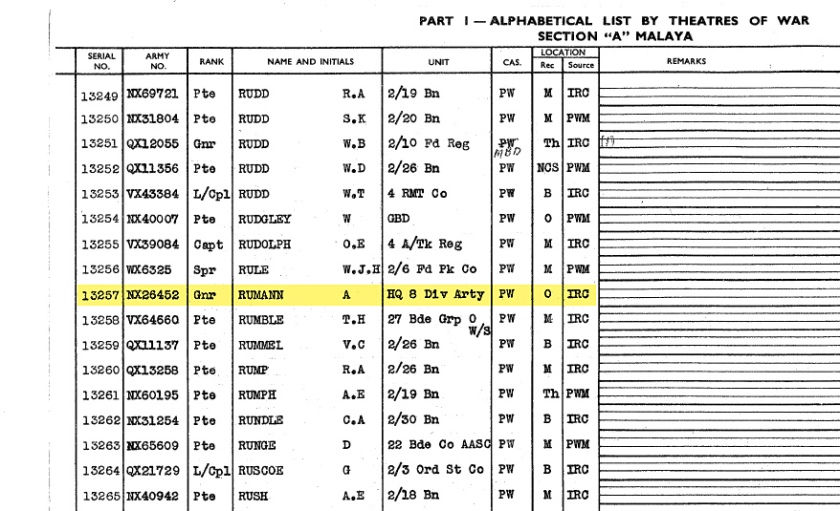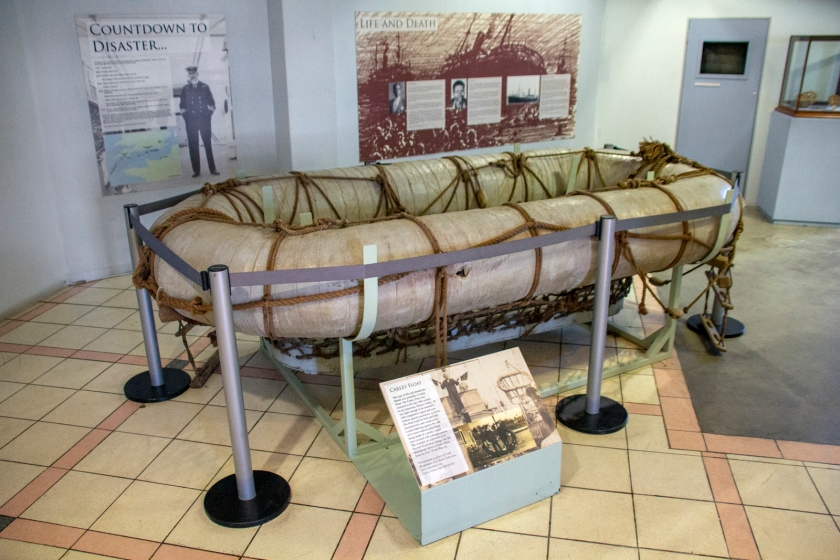October 2020
Andrew Rumann (Australian, 1905-1974)
Untitled [Departure from Circular Quay, Sydney for Fremantle and Singapore]
1941
Silver gelatin photograph
5.5 x 5.3cm
These photographs were given to me in an envelope titled “Gunner Andrew Rumann embarkation for Singapore, August 1941”. I have carefully digitally scanned and cleaned them. The attribution seems correct for the first group of photographs in the posting, Departure from Circular Quay, Sydney for Fremantle and Singapore, but not for the rest. I have located Rumann’s POW record and found several pictures of the ship he would have taken to travel to Singapore.
The other photographs in the posting show Australian armed services personnel (none are American), but there are several anomalies that enable me to say that these are later photographs. Four Australian women personnel stand in front of an American Red Cross sign, and the ARC (or Amcross) did not arrive in Australia until 1942. And in the photograph Transportation Corps US Army BKC*23, the men an women are standing on a US Army transportation barge, unlikely to have been in Australian waters before 1942. Behind them Carley floats hang from their tethers.
As always, what interests me most about these photographs are the details contained within: the casualness of the men waiting at Post Exchange No. 2, with their sandals, singlets and slough hats; the man caught mid-clamber, climbing up into the truck in Taking out the rubbish; the women in dark glasses and hat sheltering her eyes from the sun in BKC*23; the men peering out of the portholes in the same photograph, one with a fag in his mouth.
We can feel the heat emanating from these photographs (it must be summer). All the men are in shorts and topless. In photographs such as Transportation Corps US Army BKC*23 and Embarkation we can admire their lithe bodies, and observe the ubiquitous 1940s mop of curly hair with short back and sides. They were already athletic before departure, but imagine fighting in the stinking hot forests of Burma on Army rations, or ending up in a Japanese prisoner of war camp, with so little meat on the bone to start with. You would be a skeleton before long. Finally, there is one personal sign that you can make out in the crowd seeing off the troops to Singapore from Circular Quay in 1941. “Jim Carr” it reads. Did he survive the war? Who knows.
More than 15,000 Australian soldiers were captured at the fall of Singapore. Of these, more than 7000 would die as prisoners of war, some in transport ships on their way to Japan, sadly torpedoed by Allied submarines. Andrew Rumann survived his trip to Japan as a POW and returned to Australia after the war. He died in 1974 aged 68 years old.
Dr Marcus Bunyan
All photographs have been digitally scanned and cleaned by Marcus Bunyan. Please click on the photographs for a larger version of the image.
Gunner Andrew Rumann
Headquarters, Royal Australian Artillery, 8th Division, Australian Imperial Force (AIF)
Service Number – NX26452
Date of birth – 13 Sep 1905
Place of birth – Hungary
Place of enlistment – Paddington NSW
Next of Kin – Rumann, Rena
Malaya, captured at Singapore
Camp: Osaka, Japan
Andrew died in 1974 in Toor, Australia at 68 years old
In January 1941 a large component of the Australian Army’s recently raised 8th Division was posted to Malaya. An element of some 6000 men departed Sydney in the liner Queen Mary as part of Convoy US9 on 4 February 1941, arriving in Singapore two weeks later on 18 February. A further 5000 troops in Convoy US11B arrived at Keppel Harbour on 15 August 1941. Under the command of Major General Gordon Bennett, the force initially established its headquarters at Kuala Lumpur. Bennett had urged for specific territorial responsibility for his Division, and this resulted in an area which included Johore and Malacca, coming within his responsibility.
The Australian Army 8th Division in Malaya eventually reached about 15,000 men. An apt description of the commander, Major General Henry (Gordon) Bennett, found in a Veterans’ Affairs publication, (Moremon & Reid 2002) reads:
“A prominent citizen soldier, he had proven himself in World War I to be a fierce fighter and leader, but he was well known for his prickly temperament, argumentative nature and proneness to quarrel. His relations with senior British commanders and staff in Malaya were, at times, strained, as he grappled to maintain control of the Australian troops.”
Bennett’s independent spirit did not fit into the Allied command structure, however his Division generally acquitted themselves well against a seasoned enemy.
Walter Burroughs. “The Naval Evacuation of Singapore – February 1942,” on the Naval Historical Society of Australia website. June 2019 edition of the Naval Historical Review [Online] Cited 04/09/2020.
Convoy US11B
Departed Sydney 29/7/1941 – Arrived Fremantle 6/8/1941
Departed Fremantle 8/8/1941 – Arrived Singapore 15/8/1941
Ships: Johan Van Oldenbarnevelt, Katoomba, HMAS Sydney, Marnix Van St. Aldegonde, HMAS Canberra, Sibajak.
In late July 1941 a convoy was organised to transport 8th Division troops to Singapore. The convoy included three Dutch passenger ships, and escort ships from the Royal Australian Navy.
Summary of Embarkation for Johan van Oldenbarnevelt (HMT FF)
The following troops embarked Johan Van Oldenbarnevelt at Woolloomooloo, Sydney on 29/7/1941 for the voyage to Singapore.
61524 – 8 Division Artillery
29 men arrived including 3 officers, 1 warrant officer, 3 sergeants, 22 corporals and privates.
(Source: Australian Army War Diary 1/15/14 – District Records Office Eastern Command May – July 1941)
Troopship 32 – Voyage 4
She [JVO] departed Sydney on July 17 and headed for Auckland New Zealand where she arrived on July 21 and departed again on the 22nd. She returned to Sydney arriving on July 25 and departed again on the 29th, sailing via Fremantle to Singapore arriving on August 15. End of Troop voyage 4.
Johan van Oldenbarnevelt on the way to Fremantle, 1/8/1941
Aerial Starboard side view of the Dutch liner Johan van Oldenbarnevelt transporting Australian troops to the Middle East as part of convoy US11B. Note the 4.7 pound gun and 12 pounder AA gun aft
1st August 1941
Australian War Memorial Naval Historical Collection
Public domain
Trooper Johan van Oldenbarnevelt is seen departing Wellington New Zealand during Troop Voyage 6 on September 15, 1941 – Note the guns up on the aft section!
Andrew Rumann (Australian, 1905-1974)
Untitled [Departure from Circular Quay, Sydney for Fremantle and Singapore]
1941
Silver gelatin photograph
5.5 x 5.3cm
Circular Quay with the Sydney Harbour Trust building at left in the background. The spire is the CQ Fire Station No. 3.
Andrew Rumann (Australian, 1905-1974)
Untitled [Departure from Circular Quay, Sydney for Fremantle and Singapore]
1941
Silver gelatin photograph
5.5 x 5.3cm
Andrew Rumann (Australian, 1905-1974)
Untitled [Departure from Circular Quay, Sydney for Fremantle and Singapore] (detail)
1941
Silver gelatin photograph
5.5 x 5.3cm
NX26452 Gunner Andrew Rumann POW entry
Anonymous photographer (Australian)
Untitled [Encampment]
1942-1945
Silver gelatin photograph
5.5 x 5.3cm
Anonymous photographer (Australian)
Untitled [Women standing in front of an American Red Cross sign]
1942-1945
Silver gelatin photograph
5.5 x 5.3cm
The American Red Cross (ARC or Amcross) in Australia during WW2 became the largest hotel and restaurant chain in Australia at the time. Amcross was headed by Norman H. Davis with its headquarters in Sydney, NSW. …
Four American women led by Miss Helen Hall arrived in Australia in about late August 1942 to take charge of American Red Cross Service Personnel and to establish new American Red Cross centres and to extend existing centres. Miss Hall was the administrative assistant to the delegate in charge of American Red Cross Service Clubs and Leave Areas in Australia. The other three women were Miss Hannah More Frazer, who was appointed Director of the American Red Cross Service Club in Melbourne in about September 1942; Miss Florice Langley who opened an ARC Service Club in Cairns, in far north Queensland; and Mrs. Anita Woodworth who opened an ARC Service Club in Charters Towers in north Queensland.
Anonymous photographer (Australian)
Untitled [Post Exchange No. 2]
1942-1945
Silver gelatin photograph
5.5 x 5.3cm
Anonymous photographer (Australian)
Untitled [Post Exchange No. 2] (detail)
1942-1945
Silver gelatin photograph
5.5 x 5.3cm
Anonymous photographer (Australian)
Untitled [Taking out the rubbish]
1942-1945
Silver gelatin photograph
5.5 x 5.3cm
Anonymous photographer (Australian)
Untitled [BKC*23]
1942-1945
Silver gelatin photograph
5.5 x 5.3cm
Anonymous photographer (Australian)
Untitled [BKC*23] (detail)
1942-1945
Silver gelatin photograph
5.5 x 5.3cm
Anonymous photographer (Australian)
Untitled [Transportation Corps US Army BKC*23]
1942-1945
Silver gelatin photograph
5.5 x 5.3cm
Mike Peel
Carley float
2018
CC-BY-SA-4.0
Carley float
The Carley float (sometimes Carley raft) was a form of invertible liferaft designed by American inventor Horace Carley (1838-1918). Supplied mainly to warships, it saw widespread use in a number of navies during peacetime and both World Wars until superseded by more modern rigid or inflatable designs. Carley was awarded a patent in 1903 after establishing the Carley Life Float Company of Philadelphia. …
Simply by casting it over the side, the lightweight Carley float could be launched more rapidly than traditional rigid lifeboat designs, and without the need for specialised hoists. It could be mounted on any convenient surface and survive the battering against the ship’s sides during heavy seas. Unlike the rubber inflatable rafts of the period, it was relatively immune to compromise of its buoyant chambers. Seafarers in it were however completely exposed to the elements, and would suffer accordingly. An inquiry of 1946 reported that many sailors who had succeeded in getting to the safety of Carley floats had nevertheless succumbed to exposure before rescue could be made. The crew of the Canadian minesweeper HMCS Esquimalt, sunk offshore of Nova Scotia in April 1945, lost at least 16 to hypothermia during the six hours in which they awaited rescue. Few of the survivors could still walk.
Despite these shortcomings many seamen did owe their lives to the Carley float. Chinese sailor Poon Lim survived for a record 133 days adrift in the South Atlantic aboard a Carley float after his freighter SS Benlomond was sunk on 23 November 1942. He fashioned fishing gear from components of the raft. He was close to death when discovered off the coast of Brazil on 5 April 1943, but was able to walk ashore unaided.
Though its occupant did not survive, a shrapnel-ridden Carley float carried the body of an unknown man to land on Christmas Island in February 1942. The sun-bleached corpse had evidently spent a lengthy period at sea, though to this day it remains unknown from where the sailor had come. It has long been suspected that the body was that of a sailor from HMAS Sydney, which was lost with all hands under mysterious circumstances off the coast of Australia on 19 November 1941. A second Carley float, more confidently believed to be from Sydney, was recovered drifting 300 km off the Australian coast one week after the ship sank. It had been badly damaged by shellfire, but was empty. The float is now displayed at the HMAS Sydney exhibit of the Australian War Memorial, Canberra.
Text from the Wikipedia website
Anonymous photographer (Australian)
Untitled [Transportation Corps US Army BKC*23] (detail)
1942-1945
Silver gelatin photograph
5.5 x 5.3cm
Anonymous photographer (Australian)
Untitled [Embarkation]
1942-1945
Silver gelatin photograph
5.5 x 5.3cm
Anonymous photographer (Australian)
Untitled [Embarkation] (detail)
1942-1945
Silver gelatin photograph
5.5 x 5.3cm

![Andrew Rumann. 'Untitled [Departure from Circular Quay, Sydney for Fremantle and Singapore]' 1941 Andrew Rumann. 'Untitled [Departure from Circular Quay, Sydney for Fremantle and Singapore]' 1941](https://artblart.com/wp-content/uploads/2015/02/embarkation-h.jpg?w=840)


![Andrew Rumann. 'Untitled [Departure from Circular Quay, Sydney for Fremantle and Singapore]' 1941 Andrew Rumann. 'Untitled [Departure from Circular Quay, Sydney for Fremantle and Singapore]' 1941](https://artblart.com/wp-content/uploads/2015/02/embarkation-c.jpg?w=650&h=634)
![Andrew Rumann. 'Untitled [Departure from Circular Quay, Sydney for Fremantle and Singapore]' 1941 Andrew Rumann. 'Untitled [Departure from Circular Quay, Sydney for Fremantle and Singapore]' 1941](https://artblart.com/wp-content/uploads/2015/02/embarkation-d.jpg?w=650&h=620)
![Andrew Rumann. 'Untitled [Departure from Circular Quay, Sydney for Fremantle and Singapore]' 1941 (detail) Andrew Rumann. 'Untitled [Departure from Circular Quay, Sydney for Fremantle and Singapore]' 1941 (detail)](https://artblart.com/wp-content/uploads/2015/02/embarkation-d-detail.jpg?w=650&h=620)

![Anonymous photographer (Australian) 'Untitled [Encampment]' 1942-45 Anonymous photographer (Australian) 'Untitled [Encampment]' 1942-45](https://artblart.com/wp-content/uploads/2015/02/embarkation-j.jpg?w=840)
![Anonymous photographer (Australian) 'Untitled [Women standing in front of an American Red Cross sign]' 1942-45 Anonymous photographer (Australian) 'Untitled [Women standing in front of an American Red Cross sign]' 1942-45](https://artblart.com/wp-content/uploads/2015/02/embarkation-i.jpg?w=840)
![Anonymous photographer (Australian) 'Untitled [Post Exchange No. 2]' 1942-45 Anonymous photographer (Australian) 'Untitled [Post Exchange No. 2]' 1942-45](https://artblart.com/wp-content/uploads/2015/02/embarkation-k.jpg?w=840)
![Anonymous photographer (Australian) 'Untitled [Post Exchange No. 2]' 1942-45 (detail) Anonymous photographer (Australian) 'Untitled [Post Exchange No. 2]' 1942-45 (detail)](https://artblart.com/wp-content/uploads/2015/02/embarkation-k-detail.jpg?w=650&h=651)
![Anonymous photographer (Australian) 'Untitled [Taking out the rubbish]' 1942-45 Anonymous photographer (Australian) 'Untitled [Taking out the rubbish]' 1942-45](https://artblart.com/wp-content/uploads/2015/02/embarkation-e.jpg?w=840)
![Anonymous photographer (Australian) 'Untitled [BKC*23]' 1942-45 Anonymous photographer (Australian) 'Untitled [BKC*23]' 1942-45](https://artblart.com/wp-content/uploads/2015/02/embarkation-f.jpg?w=840)
![Anonymous photographer (Australian) 'Untitled [BKC*23]' 1942-45 (detail) Anonymous photographer (Australian) 'Untitled [BKC*23]' 1942-45 (detail)](https://artblart.com/wp-content/uploads/2015/02/embarkation-f-detail.jpg?w=650&h=626)
![Anonymous photographer (Australian) 'Untitled [Transportation Corps US Army BKC*23]' 1942-45 Anonymous photographer (Australian) 'Untitled [Transportation Corps US Army BKC*23]' 1942-45](https://artblart.com/wp-content/uploads/2015/02/embarkation-g.jpg?w=840)

![Anonymous photographer (Australian) 'Untitled [Transportation Corps US Army BKC*23]' 1942-45 (detail) Anonymous photographer (Australian) 'Untitled [Transportation Corps US Army BKC*23]' 1942-45 (detail)](https://artblart.com/wp-content/uploads/2015/02/embarkation-g-detail.jpg?w=650&h=637)
![Anonymous photographer (Australian) 'Untitled [Embarkation]' 1942-45 Anonymous photographer (Australian) 'Untitled [Embarkation]' 1942-45](https://artblart.com/wp-content/uploads/2015/02/embarkation-a.jpg?w=840)
![Anonymous photographer (Australian) 'Untitled [Embarkation]' 1942-45 (detail) Anonymous photographer (Australian) 'Untitled [Embarkation]' 1942-45 (detail)](https://artblart.com/wp-content/uploads/2015/02/embarkation-a-detail.jpg?w=650&h=635)
You must be logged in to post a comment.